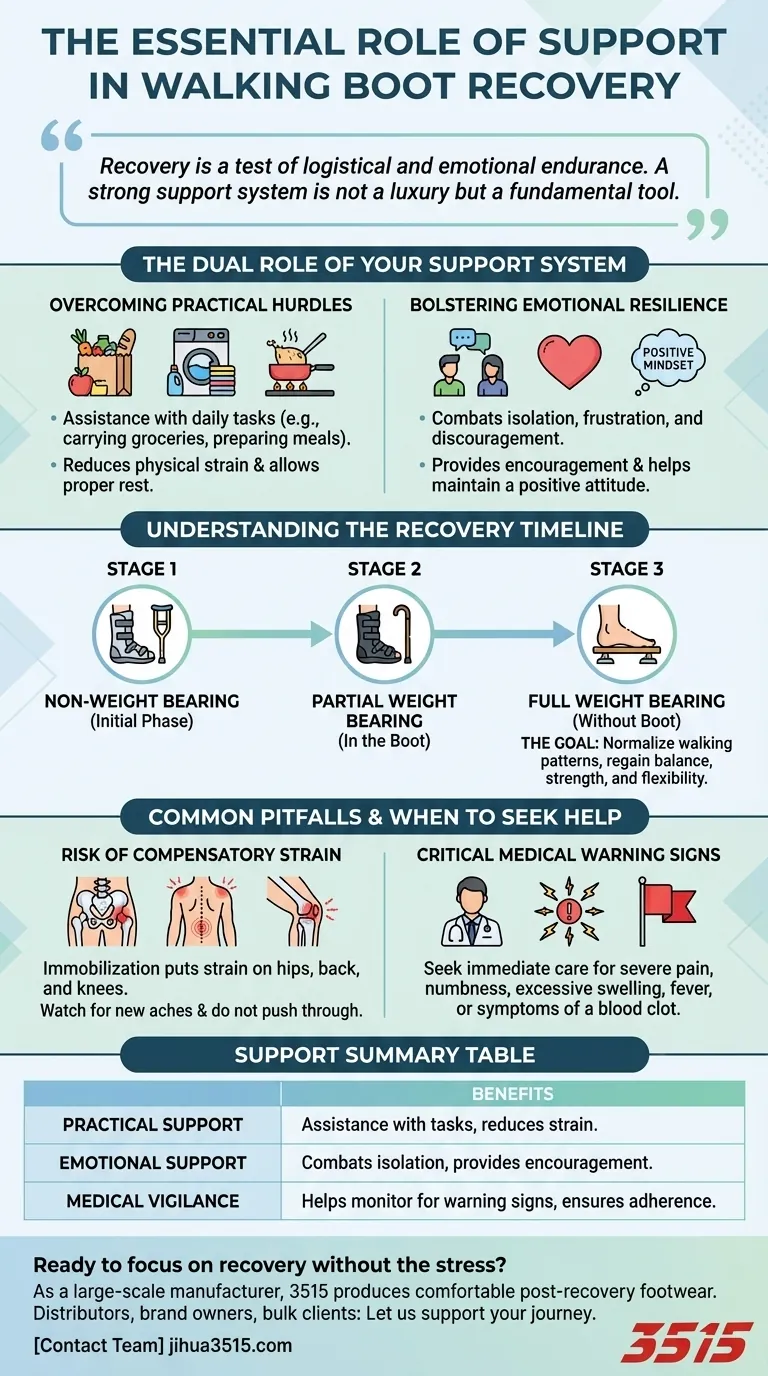Seeking support is a critical component of recovery because it addresses both the practical and emotional challenges of being in a walking boot. Relying on family, friends, or support groups provides essential encouragement, assistance with daily tasks that are suddenly difficult, and the emotional comfort needed to navigate a frustrating and often painful healing process.
Recovery from an injury requiring a walking boot is more than just a physical process; it's a test of logistical and emotional endurance. A strong support system is not a luxury but a fundamental tool for making the journey more manageable and successful.

The Dual Role of Your Support System
When you're immobilized, even partially, the world presents new obstacles. A support network helps you overcome these challenges on two distinct fronts: the practical and the emotional.
Overcoming Practical Hurdles
Assistance with daily tasks is often the most immediate need. Simple activities like carrying groceries, doing laundry, or preparing meals can become monumental challenges.
A reliable support system can step in to handle these physical tasks, allowing you to rest and prevent further injury or strain. This practical help reduces physical stress and frees you to focus purely on healing.
Bolstering Your Emotional Resilience
The mental toll of an injury should not be underestimated. Feeling isolated, frustrated, or discouraged is common when your mobility is limited.
Emotional support from friends and family provides encouragement and helps uplift your spirits. Maintaining a positive attitude by focusing on the temporary nature of the inconvenience is crucial, and having people to lean on makes this significantly easier.
Understanding the Recovery Timeline
Recovery in a walking boot isn't a single event but a series of phases. Knowing what to expect can help you and your support system prepare for the journey ahead.
The Phased Approach to Healing
Most recoveries follow a structured progression, though your specific path will be determined by your doctor.
The typical phases include non-weight bearing, followed by partial weight bearing in the boot, and finally transitioning to full weight bearing without the boot. Each phase has unique challenges where support can be invaluable.
The Goal: A Full Return to Function
The final phase is about more than just shedding the boot. It focuses on regaining balance, strength, and flexibility.
The ultimate goal is to normalize your walking patterns and ensure a complete return to function without lingering issues. This final push often requires significant patience and encouragement.
Common Pitfalls and When to Seek Help
While a walking boot is a tool for healing, it introduces its own set of challenges and risks. Being aware of them is the first step toward a safe recovery.
The Risk of Compensatory Strain
Your body is an interconnected system. When your ankle is immobilized, other joints like your hips, back, and knees must bear more movement and strain than usual.
Knees are particularly vulnerable to fatigue and pain as your body adjusts. Be mindful of new aches and pains and do not push through them.
Critical Medical Warning Signs
You must know when to contact your doctor immediately. These symptoms are not a normal part of the healing process.
Seek immediate care for severe or increasing pain, numbness or tingling that doesn't go away, excessive swelling, fever, drainage from an incision, or any symptoms of a blood clot, such as localized pain, redness, or swelling in the leg.
Making the Right Choice for Your Recovery
How you leverage your support system and manage your recovery depends on your primary goal at each stage.
- If your primary focus is a safe and speedy recovery: Use your support network for practical tasks to ensure you can rest and follow your doctor's weight-bearing instructions precisely.
- If your primary focus is maintaining your mental well-being: Actively communicate your feelings to your support system to combat isolation and stay positive throughout the challenging process.
- If your primary focus is a complete return to normal function: Listen to your body, pay attention to warning signs in other joints, and don't rush the final transition out of the boot.
Successfully navigating this period requires a holistic approach that heals both your body and your spirit.
Summary Table:
| Support Type | Key Benefits |
|---|---|
| Practical Support | Assistance with daily tasks (groceries, meals), reduces physical strain, allows for proper rest. |
| Emotional Support | Combats isolation and frustration, provides encouragement, helps maintain a positive mindset. |
| Medical Vigilance | Helps monitor for warning signs (severe pain, swelling) and ensures adherence to doctor's instructions. |
Ready to focus on your recovery without the stress? As a large-scale manufacturer, 3515 produces a comprehensive range of comfortable and supportive footwear perfect for your post-recovery needs. Whether you are a distributor, brand owner, or a bulk client, we can help you get back on your feet. Contact our team today to discuss your footwear requirements and let us support your journey back to full mobility.
Visual Guide

Related Products
- Safety Footwear Wholesale Manufacturer for Custom OEM/ODM Production
- Premium Grain Leather Safety Boots for Bulk Supply
- Wholesale Safety Footwear Manufacturer for Bulk & Custom OEM Orders
- Premium Wholesale Wheat Nubuck Safety Boot with Rapid Lacing System
- Customizable Anti-Smash Safety Boots for Wholesale & Private Label Manufacturing
People Also Ask
- What cultural and environmental considerations are tied to wearing shoes indoors? Balance Hygiene, Tradition, and Foot Health
- How long can you wear safety boots? The Lifespan is Determined by Wear, Not Time
- What are the cultural perspectives on wearing shoes in the house? A Guide to Home Etiquette & Hygiene
- What are OSHA approved shoes? Understanding the Correct Standards for Workplace Safety
- Is it normal to wear shoes in the house? A Guide to Hygiene, Comfort & Culture



















